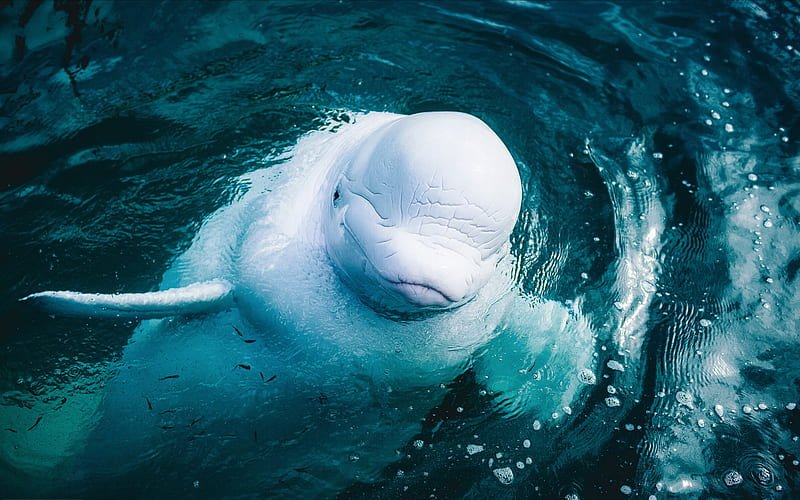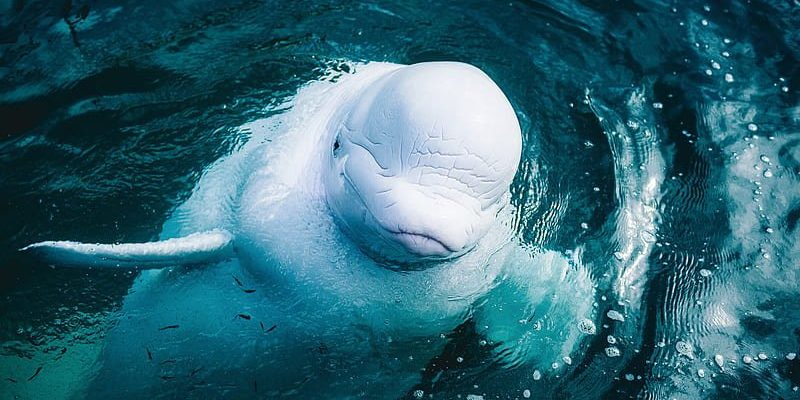
Belugas are not just cute; they’re packed with surprises. For instance, did you know that they can actually change their skin color? Yes, these whales can go from a dark gray to a bright white, depending on their age and environment. It’s like they’re putting on a new outfit for every occasion! Let’s dive into the cool facts about beluga whales that may just blow your mind.
1. They’re Social Animals
Belugas are known for their strong social connections. Just like us, they thrive in groups. You can often find them swimming in pods of 10 to 30 individuals, but sometimes they hang out with hundreds of their friends. Isn’t that cute? These pods are composed mostly of family members, showcasing tight-knit relationships. They communicate with each other using a variety of whistles, clicks, and even screams.
Imagine a bustling community where everyone is chatting away about their day. That’s what it’s like for a pod of beluga whales! They rely on these strong social bonds for support and survival, especially when it comes to raising their young. The mothers are especially devoted, often seen guiding their calves through the icy waters of the Arctic.
2. They Can Change Color
One of the coolest things about belugas is their ability to change color. As calves, they are born a grayish color, which helps them blend in with their surroundings. But as they mature, they gradually turn into a pure white. It’s like a magical transformation! This change isn’t just for looks—being white helps them camouflage in their icy Arctic habitat, making it easier to avoid predators.
In fact, the color change starts around five years old and is complete by the time they reach adulthood. Imagine going from a chameleon-like shade to a bright white snowball over the years. That’s beluga life for you!
3. They’re Vocal Creatures
Belugas are often called the “canaries of the sea” not just for fun. Their vocal abilities are truly impressive! These whales can produce over 50 different sounds for communication. From whistles to clicks and even complex melodies, belugas have a whole repertoire of noises.
You might be wondering why they have so many sounds. Well, it helps them stay in touch with their podmates and navigate through the dark waters. Think of it like a secret language that only they understand. Researchers even joke that if you close your eyes and listen closely, you might find yourself in an underwater concert!
4. They Have Flexible Neck Vertebrae
Unlike most whales, belugas have a rare flexibility in their necks, thanks to unfused cervical vertebrae. This means they can turn their heads in ways that other whales cannot. It’s like having a built-in neck massage!
This flexibility is key for their lifestyle, especially when they hunt for food. Belugas can look around and search for schools of fish without needing to twist their whole body. Picture being able to look left and right without moving—how cool is that?
5. They Can Hold Their Breath for a Long Time
When you think of diving deep underwater, you probably think of how long you can hold your breath. Belugas, on the other hand, can hold their breath for up to 20 minutes! That’s like having a built-in scuba tank.
This impressive ability allows them to dive as deep as 1,500 feet while searching for food. They mainly feast on fish, squid, and crustaceans. You might wonder how they manage to locate their meals in the dark. Well, they use echolocation, a technique that lets them “see” their surroundings by bouncing sound waves off objects. It’s like having sonar capabilities!
6. They’re Found in Arctic Waters
Beluga whales are mainly found in the Arctic and sub-Arctic waters. They love the cold and pack ice, often migrating in search of food and open water. This means they often follow the ice as it moves, showcasing their adaptability to the ever-changing environment.
You might think these icy waters would be inhospitable, but belugas thrive in them. They can even tolerate temperatures well below freezing! It’s an impressive feat that speaks to their resilience as a species.
7. They Use Tools
Yes, you read that right! Beluga whales are known to use tools. They have been observed using pieces of ice to help them hunt or even as props in social play. Imagine a child using a toy to learn or have fun; that’s exactly what these clever creatures do!
This behavior showcases their intelligence and adaptability. It’s not just about survival; it’s about enjoying life and bending the rules a bit. Who knew that belugas could be such little innovators?
8. They’re Highly Intelligent
Belugas are often considered one of the most intelligent marine mammals. Their complex social structures, communication skills, and problem-solving abilities demonstrate a high level of intelligence. Scientists have even compared their cognitive abilities to those of dolphins and great apes!
This intelligence makes them fascinating to study. Researchers often conduct experiments to learn more about how belugas think and interact. You might say they’re the Einsteins of the underwater world!
9. They Face Conservation Challenges
Like many marine animals, belugas face a range of threats due to climate change, habitat loss, and pollution. As the Arctic warms, their habitats are changing rapidly. This can affect their migratory patterns and food sources, putting additional stress on their populations.
Conservation efforts are underway to protect these amazing creatures. Organizations are working hard to raise awareness and develop strategies to help ensure the beluga whale continues to thrive. It’s a team effort, and every little bit counts!
10. A Symbol of the Arctic
Finally, beluga whales hold a special place in the cultures of many northern peoples. They are often viewed as symbols of the Arctic and are celebrated in local traditions and stories.
For many Indigenous communities, belugas are more than just animals—they represent a deep connection to the sea and the environment. They remind us of the delicate balance within our ecosystem and the importance of respecting and protecting it.
In conclusion, beluga whales are truly remarkable creatures. From their vocal talents to their social behaviors, they capture our imagination and highlight the complexity of marine life. As you think about these amazing animals, remember that they are not just residents of the ocean; they are a vital part of the world we share. Let’s work towards a future where belugas continue to thrive!

